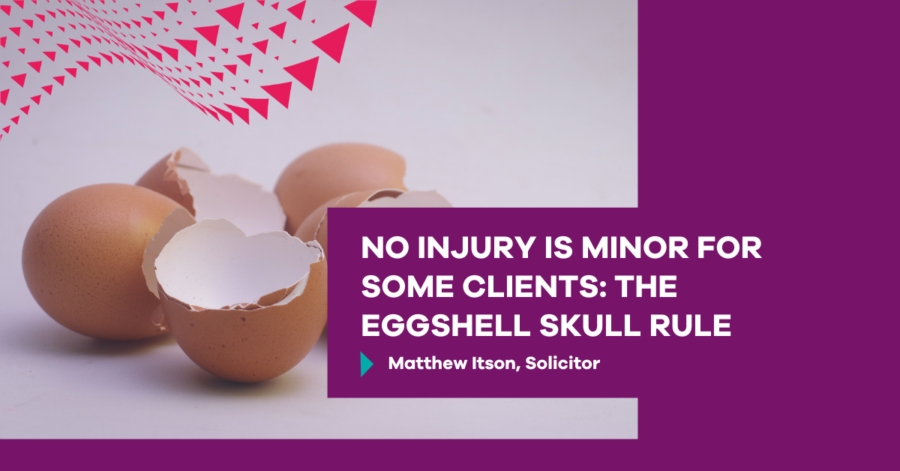No injury is minor for some clients: The eggshell skull rule


Matthew Itson, a solicitor at Minster Law, shares his recent client case and how the eggshell skull rule came into play.
If any of us was travelling at 50 mph and saw a vehicle pull out and across our path, the first thing we’d do is slam on the brake. But in this case, when a young driver set off from a side road without looking and into oncoming traffic, the first thing my client did was reach for the hand-controlled brakes on his specially adapted vehicle.
That’s because his legs had long-since stopped responding when his brain sent them a command after he’d suffered a life-changing spinal cord injury in a previous collision in 1990.
My client did the best he could to avoid a collision – swerving so the impact was less direct and staying away from a stationary vehicle at the scene. But this didn’t keep his Ford Mondeo from striking the bonnet of the other driver’s car and going up and over it before settling in a grass verge.
Thanks to his actions, the collision was not as serious as it could have been. Most people would likely have been able to walk away from it, but my client hadn’t walked for over 30 years.
The eggshell skull rule – what is it?
There’s a well-known principle in personal injury law called the eggshell skull rule. It’s one with which every law student will be familiar. In essence, if the injured person is unexpectedly fragile, it doesn’t allow the person who’s been negligent (or their insurer) to escape the consequences their negligence causes – you take the injured person as you find them.
My client was this principle come to life, leaping from my tort law textbooks and made real. Thankfully, he hadn’t fractured any bones or suffered a further spinal cord injury. But he had taken a knock to the head, and crucially, he’d suffered a dislocated right clavicle and hyperextended his left elbow in the impact. He’d also been struck in the right side by the interior of the vehicle as he was tossed about.
All injuries that would have normally meant the case would not be dealt with by Minster Law’s Serious Injury Team. But this was an incredibly vulnerable client, and it was clear to Minster from the outset that even relatively minor injuries could have a catastrophic effect on his life.
If I dislocated my clavicle, I’d manage. My livelihood isn’t dependent on me doing a press-up thankfully. But my client needed his upper limbs to simply move.
He needed them to get out of his adapted bed, to transition into his manual wheelchair. And once he was in the wheelchair, he had to use his arms to mobilise everywhere. To the toilet where he would need to transition again onto the adapted commode. To get to his adapted vehicle where he would drive to his twice-weekly therapy appointments. At one of these appointments, the whole purpose would be to stand him up using bespoke equipment and to exercise muscles he couldn’t use on his own.
So, this was the condition he was in when the defendant injured him. He had a team of people he needed to visit every week to simply stand. Never mind that his specially adapted vehicle had been written off in the collision, so he couldn’t even drive to this appointment even if he could mobilise to his car using his wheelchair, which he couldn’t.
He was also having increased autonomic dysreflexia attacks. For people who have suffered spinal cord injuries, these occur when there is an imbalanced reflex sympathetic discharge in the nervous system. They often manifest in the form of headaches, increased blood pressure and bladder and bowel symptoms, all of which my client was suffering post-collision, and they come on generally when the person’s health is worsening. As my client explained, ‘they’re a way of telling me something is wrong in my body that I can’t otherwise feel.’
And most worryingly, they can be fatal.
So, after getting a 360-degree view on how the collision upended my client’s life, the next step was getting it to the right person working for the defendant’s insurer, and then pressing to get the rehabilitation process started immediately. Each day that my client sat at home in pain, unable to attend his scheduled therapies, could be detrimental to his health.
Fortunately, the claim was promptly allocated to a handler who dealt with large-loss injury claims almost straight away, and he instantly appreciated just how precarious my client’s position was. It’s overwhelmingly better for everyone when the parties work collaboratively, including the injured person, who we believe should be at the heart of the process.
I’d found a specialist nurse who’d worked for years at Stoke Mandeville’s National Spinal Injuries Centre, and she was perfect to lead on the rehabilitation process. The insurer paid for her to visit the client and conduct an Immediate Needs Assessment straight away. In a strange coincidence, she’d even treated my client 3 decades earlier when he’d first suffered his spinal cord injury.
Funds for my client to have live-in care, transportation and additional therapy sessions were all agreed. Further adaptations were also installed in his home, such as grab rails, a bath lift and air mattresses. Psychotherapy was also provided and proved vital to keep him in the right headspace to continue with his physiotherapy.
The most transformative measure we put in place was a powered wheelchair so his upper body could simply rest and recover from his injuries. The insurer agreed to fund a 1-year hire, as well as funds for a hoist so that it could be loaded and unloaded into his new car.
I won’t pretend it was all plain sailing. There were literally thousands of pages of medical records to request and consider for someone who had such a complicated history. I couldn’t also get all the adaptations made to his home I’d wanted. Not because the insurer wouldn’t fund them, but because my client was going through a messy divorce, and the scope of what could be done to a home still in both he and his wife’s name was limited.
But it’s also the type of claim I find most rewarding. Because my client didn’t have to wait until the end of it to see real, tangible ways his life was improving, and I can truly say that when it concluded nearly 2 years later with a fantastic settlement for him, he was truly in a better place than when I’d first met him on the June afternoon.
In his own words, ‘I was extremely impressed and satisfied by the professionalism of the team who work so hard in this company. They me updated on every aspect of the claim and made sure I got the best possible outcome from my case.’
It’s truly a privilege to do this job. I do well to remember that. And to remember that you never know just how vulnerable that other driver behind the wheel is when you pass them on the road.